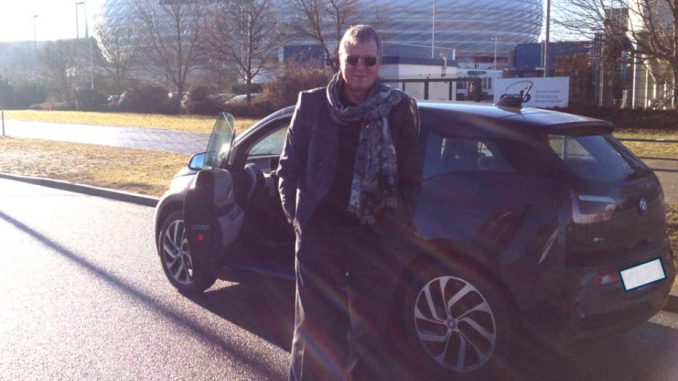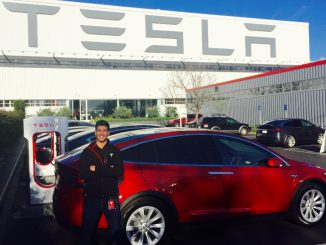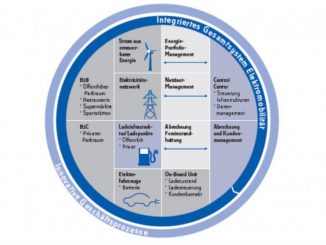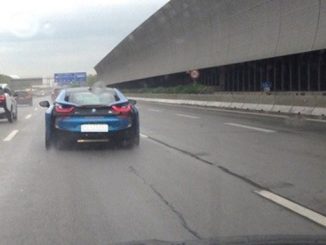
The Role and Future of Electro-mobility. This article is Part 3 of a series and focuses on research contribution. Part 1, Part 2
Economic and ecological necessities make electro-mobility an attractive solution for the future. The turn is now on the economy, on politics and energy policies to find ways to sustainably establish electro-mobility on the market. But what are the possible contributions of the research sector?
The research and development project SMART EM (SMART EM 2013) has been founded with the goal to find answers to this question. SMART EM wants to identify suitable business and market models as well as a technical infrastructure to support the long-term success of electric cars. “The successful introduction and proliferation of electro-mobility not only requires technical solutions such as standardized charging stations, more efficient battery technologies or an increased reach by an optimized energy management of the vehicle,” emphasizes Prof. Dr. Gregor Engels, scientific coordinator of the project. “Much rather, we need feasible business and market models that take the different interests of people, companies and the government into account.” According to the conviction of the project entity, electro-mobility will accomplish success as a groundbreaking mobility concept only if these requirements are met.
“Sustainability of these market and business models will be identified and appraised with the help of future scenarios, computer simulation and mathematical optimization methods,” explains Dr. Stefan Sauer, project manager and business manager of the s-lab – Software Quality Lab at the University of Paderborn. Its project partners will supply the required data: They are the University of Paderborn and the power company Westfalen Weser Energie (previously E.ON Westfalen Weser), the Paderborn-based IT companies Morpho and Orga Systems as well as UNITY AG, a management consultant. “We will develop a cross-sectorial model from the data we compile, and they will flow into the simulation,” says Dr. Sauer.
“In addition to technological developments, we will investigate the impact of dynamic tariff systems on user and system behavior,” underlines Dr. Dirk Fischer, head of the research department of the invoicing expert Orga Systems, his company’s keen interest in the project. “Morpho explores the safe identification and communication of vehicles and components within a charging infrastructure,” explains Carsten Rust, project manager of the leading identification and safe documentation company. “Westfalen Weser Energie supplies relevant net data for the project and describes the impact of these models on grid scheduling and operation,” outlines Manfred Junker from the regional power company. From these findings, UNITY AG should be able to extract several innovative consulting approaches now needed for outlining future business models for existing and potential customers. “Electro-mobility comes along with considerable changes and risks which we can counter by sustainable business models,” explains Tomas Pfänder, member of the supervisory board of UNITY AG, with regard to goals.
Because such a holistic approach takes many experts from a wide array of fields, altogether five institutes of the university are uniting their efforts: the two chairs in business informatics of Prof. Dr. Leena Suhl and Prof. Dr. Dennis Kundisch, the information technology institutes C-LAB and s-lab, headed by Prof. Dr. Engels, and the experts for high efficiency calculation of the Paderborn Center for Parallel Computing (PC2) under the leadership of Prof. Dr. Holger Karl. With UNITY AG, Munich Business School also adds the marketing perspective to the project. With the goal to create a common and shared vision about future structures and frame conditions for electro-mobility for all project partners, the project organization developed various future scenarios by means of scenario planning. In the SMART EM project, scenarios provide important input for simulation, because this is where external frame conditions are defined and different development strands can be analyzed.
In a first step, the project partners compiled and described all factors that could possibly influence the future of electro-mobility. A system analysis helped to identify factors with strong interdependence that represent pivotal points for future developments. In a next step, possible future projections for these so-called key factors were developed and presented in detail in a catalogue. Altogether four scenarios, which represent the entire bandwidth of future developments, emerged from putting together inherently consistent projections of various key factors. From limited prospects for electro-mobility to a niche existence or to an equivalent alternative to other drive technologies up to the nationwide breakthrough of e-vehicles: The scenarios include all potential future strands of development.
In particular, it must be taken into account that users of electric cars are a heterogeneous group; a one-fits-all offer is therefore doomed to fail. In addition to the services themselves, customer-oriented IT processes will have a significant influence on the success of electro-mobility. Electro-mobility can be profitably marketed only if all these processes are rigorously enhanced. In this context, it is crucial to recognize and avoid falling into the traps of lacking or inefficient cross-sectorial teamwork, deficient standardization or quality issues.
As these three articles show, all stakeholders in electro-mobility must develop and calculate feasible business models. This is an essential competence for successfully using the opportunities opened by the forthcoming changes. The marketing challenges will have been successfully mastered as soon as ecological driving becomes a positive emotional experience for users.
More about the role of services as potential trailblazer for electro-mobility in a next blog.
Sources:
Deutschlandreise im Elektroauto, Teil 1: Ständig unter Strom, 2014:
http://www.spiegel.de/auto/fahrkultur/im-elektroauto-tesla-model-s-durch-deutschland-a-982772.html
Bundesministerium für Umwelt, Naturschutz, Bau- und Reaktorsicherheit 2011:
http://www.bmub.bund.de/N47370
BMW i3 – Official Launch Video 2013:
http://www.youtube.com/watch?v=g1LsT1PVjUA
Kraftfahrzeugbundesamt 2014:
http://www.kba.de/DE/Presse/Pressemitteilungen/2011_2015/2014/Fahrzeugzulassungen/pm04_14_kurzzulassungen_2013_komplett.html?nn=1112104
Projekt e-mobility 2011:
Eine elektromobile Zukunft ohne Grenzen, in: Roessler, Ph. Et al.: Innovationspolitik, Informationsgesellschaft, Telekommunikation – IKT für Elektromobilität vom August 2011, S. 13, Berlin 2011.
SMART EM 2013:
http://www.smart-em.de/news/single/article/wohin-fuehrt-uns-die-elektromobilitaet
Smart electric drive arrives on the streets of China 2013:
https://media.daimler.com/dcmedia/0-921-1653617-1-1652022-1-0-1-0-0-0-0-1549054-0-1-0-0-0-0-0.html
Volkswagen e- mobility 2014:
http://emobility.volkswagen.de/de/de/private/Autos.html




